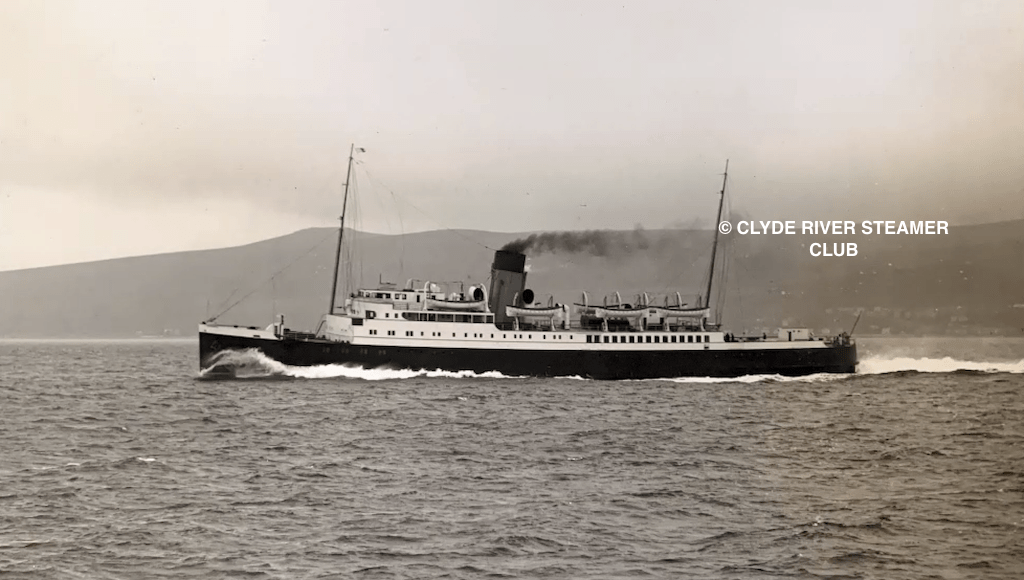
Among the Denny cross channel turbines renowned for their speed was Brighton: launched in November 1932 and handed over to the Southern Railway Company in March 1933 for their Newhaven-Dieppe service, she achieved 24.69 knots on trials on the Skelmorlie Mile
On Wednesday 13 October Andy Anderson gave his presidential address, titled ‘An Appreciation of A Builder of Fine Ships’ and enjoyed by an online Zoom audience of 90. Among them was Club member Iain MacKinnon, who says Andy’s talk was as instructive as it was entertaining.
A video of the talk, featuring approximately 100 first-class images, can be accessed by paid-up CRSC members here. If you are not yet a member, please consider joining for £10 here: this will give you access to other ‘members only’ posts, featuring hundreds of photos from the Club archive.
If beauty is in the eye of the beholder, writes Iain MacKinnon, then the 2021 president’s address was a look at the finest products of Denny of Dumbarton through the eyes of Andy Anderson.
Telling us at the start that his talk would be a personal view of favourite ships rather than an academic study, Andy went on to prove he had been more lost in the pages of books in Glasgow’s Mitchell Library than he would have us believe.

During a recent visit to Queen Mary at Glasgow’s Science Centre, Andy Anderson was allowed to hold the builder’s plate of the Denny-built vessel, while his wife Gill admired one of the ship’s restored lifebelts
His explanation of Denny family genealogy, for example, was well laid out, as was his emphasis on the pioneering role the Dumbarton yard played in many aspects of shipbuilding and engineering. Ships deployed as blockade runners in the American Civil War had to be fast, and this became a characteristic of Denny ships, notably after the yard created the world’s first test tank. Early use of steel was accompanied by progressive working practices such as generous pay for women.
The first ship Andy mentioned was Cutty Sark, the building of which was begun by Scott and Linton and completed by Dennys. She made a suitable starting point for the evening because, while viewed as the pinnacle of sail, she was eventually eclipsed by the arrival of steel and steam, which fuelled the company’s growing prosperity.
Few ships embodied this better than Duchess of Hamilton of 1890, the first Clyde steamer to be built with the promenade deck extended to the bow. The picture Andy displayed of her was a treat for those who prefer their funnels emitting atmospheric black smoke.
The advent of turbine propulsion represented a new type of ship for the new century, and Dennys were leaders of the class. The first commercial turbine passenger steamer in the world, launched at Dumbarton in 1901, was King Edward. This gave Andy an excuse to tell us of a once-favourite pastime of ‘wake riding’ — the practice of taking a rowing boat as close to a moving steamer as possible. Aiming at midships as the vessel swept past gave many a young holidaymaker a thrill, as the smaller craft would be lifted over the waves left by the large ship.
Many Denny-built favourites followed, including Duchess of Argyll, the 1925 Glen Sannox and the 1912 Queen Alexandra. Illustrating individual ships in collage was a style favoured by Andy, who could not resist playing ‘two funnels/three funnels’ when Queen Alexandra emerged as Saint Columba in 1936.
The sight of King George V, dressed overall for CCA charter to Bangor in 1970, brought a dash of colour, but we were also informed of the onerous duties she undertook during the Second World War — including five return trips to evacuate troops from Dunkirk in 1940, for which her crew were awarded distinguished service honours.
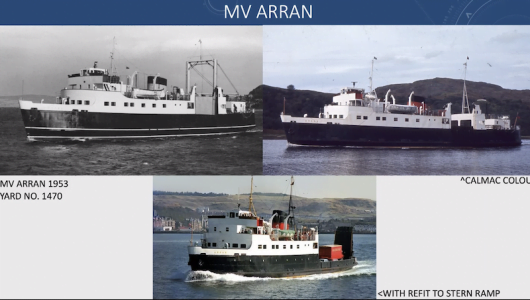
One of Andy’s collage illustrations featured the various transformations of Denny-built side-loader Arran of 1953, the Clyde’s first purpose-built car ferry
Duchess of Montrose of 1930 showed a fine bow wave and was hailed as faster than her sister ship Duchess of Hamilton, built two years later by Harland & Wolff.
Queen Mary II’s wide beam and large capacity was highlighted, notably so in a scene showing her at Craigmore pier as Duchess of Montrose headed past in the opposite direction. On the subject of funnels, our speaker came firmly off the fence by declaring his preference for the ‘Mary’ with only one lum.
We saw the 1934 Caledonia with her controversial concealed paddle boxes and heard details of international orders signalling an era when steamers would give way to motor vessels.
These included Lochfyne of 1931, the first diesel electric vessel to be employed in British coastal waters. Andy shared his personal experience of the vibrations the ship was known for. On board, his elder brother Gibbie encouraged him to rest his chin on a guard rail knowing full well this would rattle the teeth of his younger sibling. The story was a classic from the man who introduced himself at the Club’s first Zoom meeting by saying‘ if you ever forget my name, just call me Gibby’s little brother’.
The 1947 Loch Seaforth was shown in two contrasting pictures at Mallaig — one in colour and the other, in black and white, having the character of a pleasing line drawing.
The speeds Dennys ships obtained attracted orders for the Thames and cross channel routes. Particular stars were Paris of 1913, said to be the fastest ship in the world in proportion to her size, and Isle of Sark of 1931, the first to trial the Denny Brown stabiliser.

Caledonia, pictured arriving at Rothesay in the mid 1930s, pioneered the controversial concealed paddle-box
The stabiliser was so successful that it was eventually installed on ships such as the Royal Yacht Britannia and the Cunard liner Queen Elizabeth.
The test tank was another Denny technical innovation. Now the site of a museum (and apparently a source of ‘continuous learning’ for our speaker at every visit), it was referred to as the ‘mother tank’ because Dennys helped others such as Mitsubishi to set up similar tanks around the world.
Innovative in marketing as well as technology, the Dumbarton yard advertised special orders such as the Snark of 1882 — a deluxe tender/tug featuring leather sofas, mahogany fittings and ladies cabin.
Picking up speed Andy took us across the channel on many Denny vessels, culminating in Bardic Ferry, the first British Ro-Ro ship, and Caledonian Princess, Dennys’ last major unit.
An earlier aerial view of the Leven Shipyard, situated behind the familiar landmark of Dumbarton Rock, was perhaps prophetic of Andy’s final points. It was a large site for its time, he said, configured to handle ships much smaller than today’s, but it eventually fell victim to the trend for fewer and larger ships.
The closure of the yard took place nearly 60 years ago. The company’s legacy lives on in the bulbous bow and the retractable stabiliser, even if Andy’s much admired ‘Denny look’ is no longer visible above the water line.
You can see all 100 images in Andy Anderson’s presentation in a ‘members only’ post here.
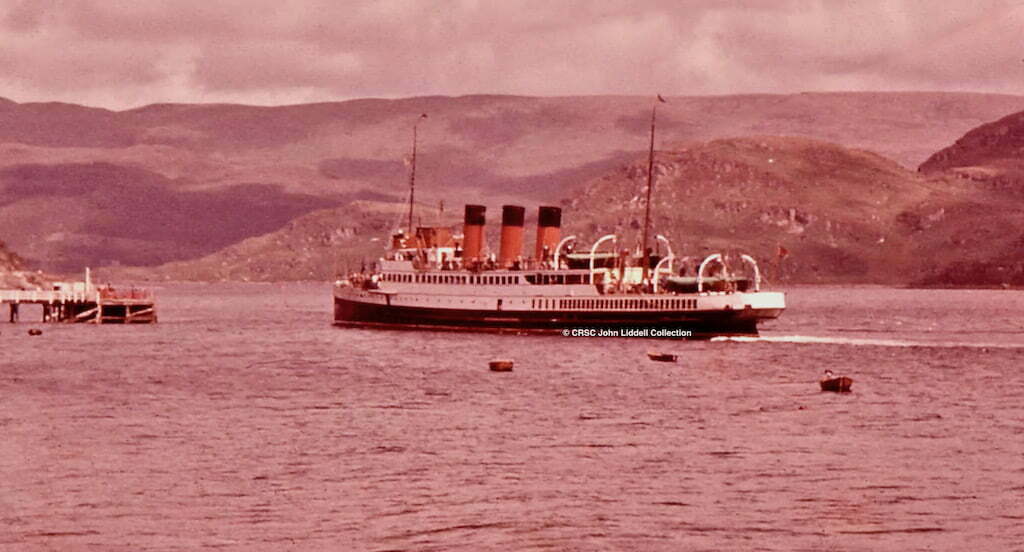
An Andy Anderson favourite: Saint Columba arriving at Tighnabruaich c1957. Built by Denny in 1912 as the twin-funnelled Queen Alexandra, she was bought by MacBraynes in the winter of 1935-36 and given a third funnel

The Denny Brown stabiliser was the prototype for what has become a standard feature on sea-going vessels

The Denny Tank at Dumbarton, where hull shapes were regularly tested for speed and stability. It is now open to public view
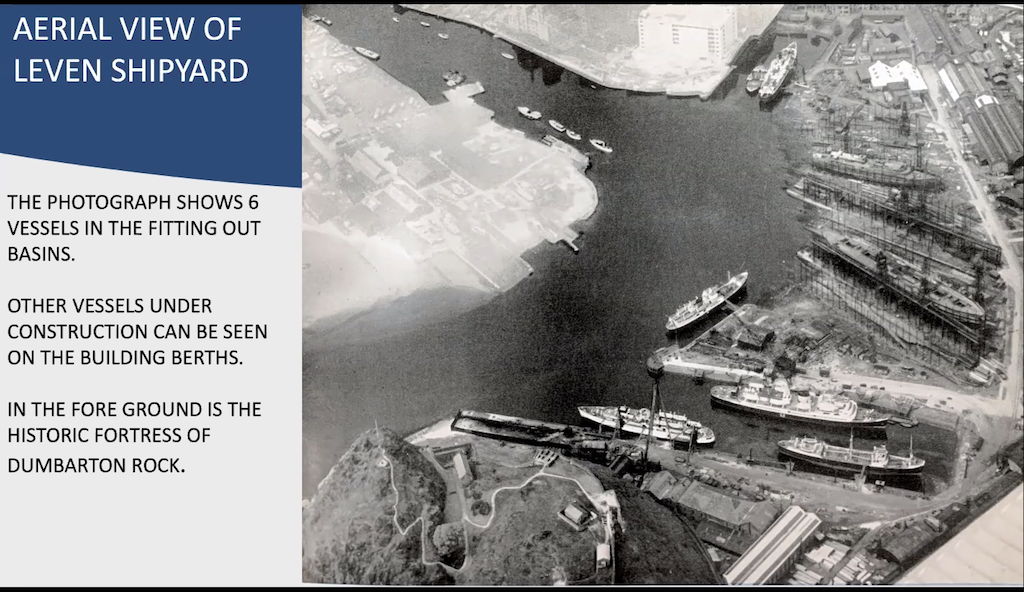
The Leven Shipyard at Dumbarton c1949, during one of its most productive phases. Among the vessels that can be identified is MacBraynes’ Stornoway mail vessel Loch Seaforth, lying diagonally centre-right during overhaul. Apart from the three ships under construction on the slipways, the remaining ships are in various stages of fitting out — the Forth ferry Mary Queen of Scots, the Thames excursion vessel Queen of the Channel, the Burns Laird cargo carrier Lairds Moor and two cross-channel vessels, Falaise and Princess Victoria
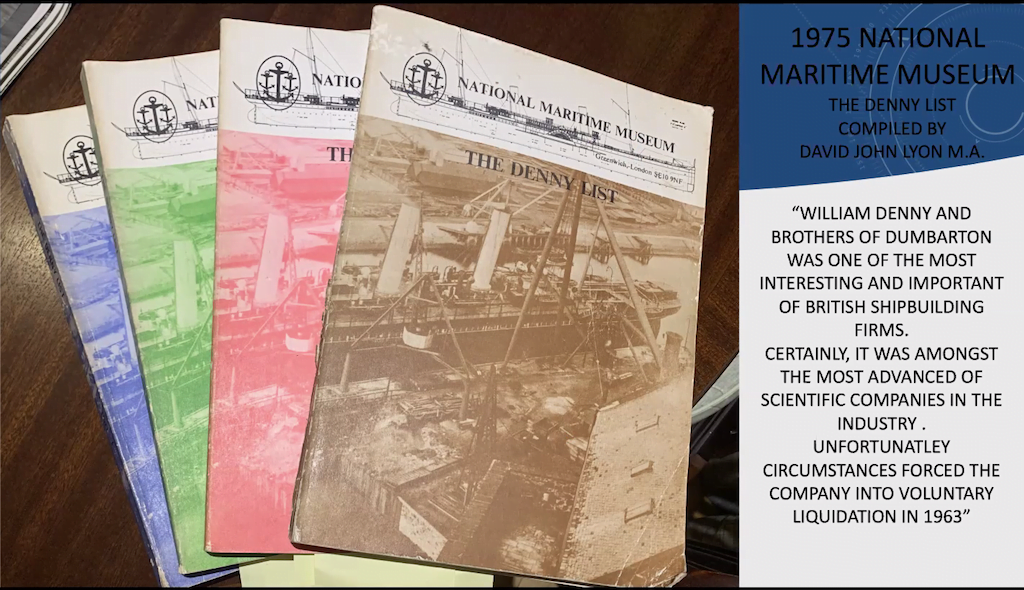
The Denny List, meticulously compiled in four volumes by the National Maritime Museum (repository of most of the Denny archives at Woolwich), is a wonderful resource for 21st century ship researchers
Join CRSC for £10 here and get the full benefits of membership, including access to hundreds of rare photographs in the Club archive.
Published on 14 October 2021











